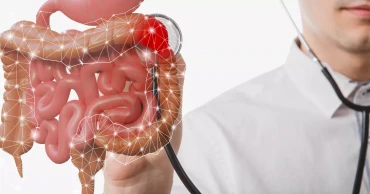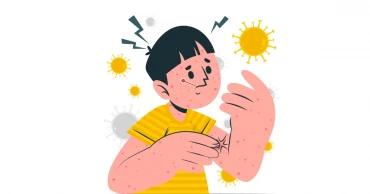Disease
Diarrhea cases surge in Manikganj, children most affected
Manikganj is witnessing a sharp rise in diarrhea cases, with children being the most affected.
The 250-bed district hospital's diarrhea unit, which has a capacity of 20 beds, is struggling to accommodate patients.
Many patients are being treated on the floor due to overcrowding, putting additional pressure on nurses and doctors.
According to hospital authorities, the number of diarrhea patients began increasing in October.
The unit treated 359 patients in October and 355 in November. The trend continued into December, with over 600 patients admitted from the start of the month until December 23.
Dengue: One more death reported in 24hrs
Alpana Akter, in charge of the diarrhea ward, said that around 20 patients are arriving daily, most of whom are children. Each child is often accompanied by two or three family members, exacerbating the space shortage. Some patients, unable to secure space, have opted for private clinics or hospitals.
Shiuli Begum, the mother of 4-year-old Akib, who is currently admitted, said that her child had been experiencing vomiting and diarrhea.
Despite some improvement after two days of treatment, symptoms persist. She also raised concerns about the ward's unhygienic conditions, which may pose additional health risks to patients and caregivers.
Furthermore, many essential medicines are unavailable, forcing families to purchase them from outside.
Dengue prevention neglected in underprivileged areas: Speakers
Dr. ABM Touhiduzzaman, residential medical officer (RMO) of the hospital, confirmed that the diarrhea unit has only 20 beds but is accommodating 30 to 40 patients daily. He acknowledged that overcrowding has led to deteriorating sanitary conditions.
However, the nurses and doctors on duty at the diarrhoea unit said they were providing medical services to the best of their ability.
They are struggling to get treatment due to the pressure of additional patients. There are enough food saline, paracetamol medicines for diarrhea patients, but due to lack of supply of Ciprocin medicines, including cholera saline, patients have to buy them from outside.
Pediatric specialist Dr. Nilufar Yasmin highlighted that cold-related illnesses are contributing to the influx of child patients. She attributed the increase in diarrhea cases primarily to rotavirus infections, which are more common in winter. To prevent further cases, she advised maintaining hygiene, keeping children warm, and avoiding cold foods.
Hospital Superintendent Dr. Baha Uddin said that additional measures are being taken to manage the patient overflow, including plans to transfer diarrhea patients to other wards. However, the current situation remains critical due to space constraints and medicine shortages.
11 months ago
Dhaka’s air quality unhealthy for sensitive groups this morning
Dhaka, the overcrowded capital city of Bangladesh, has ranked the 10th on the list of cities with the worst air quality with an AQI score of 101 at 9am this morning (October 6, 2024).
Today’s air was classified as 'unhealthy for sensitive groups', according to the AQI index.
When the AQI value for particle pollution is between 50 and 100, air quality is considered ‘moderate’, usually sensitive individuals should consider limiting prolonged outdoor exertion, between 101 and 150, air quality is considered ‘unhealthy for sensitive groups’, between 150 and 200 is ‘unhealthy’, between 201 and 300 is said to be 'very unhealthy', while a reading of 301+ is considered 'hazardous', posing serious health risks to residents.
Vietnam’s Hanoi, China’s Beijing and Wuhan cities occupied the first, second and third spots in the list, with AQI scores of 186, 158 and 156, respectively.
The AQI, an index for reporting daily air quality, informs people how clean or polluted the air of a certain city is and what associated health effects might be a concern for them.
The AQI in Bangladesh is based on five pollutants: particulate matter (PM10 and PM2.5), NO2, CO, SO2, and ozone.
Read: Dhaka’s air quality ‘moderate’ this morning
Dhaka has long been grappling with air pollution issues. Its air quality usually turns unhealthy in winter and improves during the monsoon.
As per World Health Organization (WHO), air pollution kills an estimated seven million people worldwide every year, mainly due to increased mortality from stroke, heart disease, chronic obstructive pulmonary disease, lung cancer, and acute respiratory infections.
Read more: Despite rain, Dhaka's air quality 'moderate' this morning
1 year ago
Mpox: Common Signs and Symptoms
Mpox or Monkeypox has become a global concern over the last two years since its outbreak in the Democratic Republic of the Congo in 2022. Mpox has so far crossed the boundary of Africa and made its way through Europe to Asia. To ensure the prevention of this viral disease, mass awareness is a must. Let’s take a look into the early symptoms, rash progression, risk factors, incubation period, and contagious duration of the Monkeypox disease.
Major Signs and Symptoms of Mpox
In the early stages of sickness, people affected by Mpox will simply feel unwell. They will be seemingly showing “flu-like” symptoms. Most people will only suffer from these mild symptoms and recover within a period of 2 to 4 weeks.
Early Symptoms
Early symptoms of Mpox include:
Fever: A fever is often one of the first symptoms to appear when someone is infected with Mpox. The body’s temperature rises as a natural defense mechanism to help fight off the virus. This increase in temperature can range from a mild elevation to a high fever, often making the person feel very uncomfortable. The fever may come and go in waves and can be accompanied by a few other symptoms.
Read more: Pakistan's health ministry confirms a case of mpox but more tests are being done for its variant
Headache: Alongside fever, headaches are a common early symptom of Monkeypox. These headaches can vary in intensity, ranging from mild discomfort to severe pain. The headaches are usually persistent and can make concentration and everyday activities difficult.
Chills: Chills are often experienced as sudden, involuntary muscle contractions that result in shivering. This symptom usually accompanies the fever and can make a person feel cold even when the body temperature is elevated. Chills are a response to the body’s effort to raise its core temperature to fight the infection.
Joint Pains: Joint pains, also known as arthralgia, are common in the early stages of Monkeypox. This discomfort can affect any joint of the body, including the knees, elbows, wrists, and fingers. Joint pain can range from mild to severe and may be constant or intermittent. It often leads to stiffness and difficulty in movement, contributing to the overall feeling of malaise.
Read more: Congo's humanitarian crisis helped mpox spiral again into a global health emergency
Backache: Backache is another frequent symptom, often adding to the discomfort experienced during the early stages of Mpox. The pain is usually centered in the lower back but can also radiate to other areas. This pain can be persistent and may worsen with physical activity or prolonged sitting.
Muscle Aches: Muscle aches, or myalgia, are common and can affect various parts of the body. These aches can range from dull, persistent pain to more intense discomfort that limits movement. Muscle aches can affect the entire body or be localized to specific areas, making physical activities challenging and contributing to the overall sense of fatigue.
Swollen Lymph Nodes: Swollen lymph nodes, also known as lymphadenopathy, are a key indicator of Monkeypox infection. The lymph nodes, particularly those in the neck, armpits, and groin, may become tender and noticeably enlarged. This swelling occurs as the body’s immune system ramps up its response to fight the virus.
Read more: Health ministry issues mpox alert: Vigilance at entry points; no cases detected in Bangladesh yet
Extreme Tiredness: Extreme tiredness, or fatigue, is one of the most debilitating symptoms of Mpox. This profound exhaustion goes beyond normal tiredness, leaving individuals feeling drained and unable to perform everyday tasks. Fatigue can persist throughout the illness, even when other symptoms begin to improve.
1 year ago
What is Mpox? How does it affect people?
On August 14, The World Health Organization (WHO) declared Mpox or Monkeypox as a public health emergency of international concern, which is the highest alert the organization can decree. Since its earlier detection in the Democratic Republic of Congo in 2022, Mpox has been spreading across continents contaminating and killing thousands of people.
Recently, this deadly disease has been detected in Pakistan, sprouting fear in the neighboring South Asian countries. To stay safe, mass awareness should be raised against Mpox.
What is Mpox or Monkeypox?
Mpox or Monkeypox is a disease caused by the Mpox virus. When infected by this virus, people show symptoms similar to those of smallpox, like rashes, discolored and swollen lymph nodes, headache, muscle aches, fever, and so on.
Read more: Health ministry issues mpox alert: Vigilance at entry points; no cases detected in Bangladesh yet
Quite rare in humans, the Mpox virus mostly affects rodents, like rats, and mice, and primates, like gorillas, and monkeys. However, for the last two years, a new variation has been alarmingly raising concerns about infecting humans and causing deaths.
Mpox Variations
Till now, only two variations of the Mpox virus have been found liable for human illness—Clade I and Clade II. According to researchers, the variations liable for the recent outbreak and the outbreak in 2022 are different.
The global outbreak of 2022 that infected around 100,000 people was caused by the Clade II variation, whereas, Clade I is liable for the recent situation. The two mutant types share a few differences in terms of their ways of transmission, and symptoms.
Read more: How to Keep Your Skin Healthy During Monsoon
Clade I
Clade I shows a pattern in its process of transmission, taking advantage of a person’s immunodeficiency, making them weak, and slowly pushing them towards death. The mortality rate among the Clade I victims ranges from 1% to 10%.
As per reports, the victims have been mostly the inhabitants of Congo. However, the number of victims went up due to the rapid contamination among people in other areas of the world. Clade I is more frequent among children who are infected through contact with animals or other members of their families.
Clade II
Clade II is responsible for the 2022 outbreak of Mpox. The death rate of Clade II is low, counting only 1% to 4%. The severity of the illness is also more tolerable, causing rashes on a random part of the body mostly around the face and torso instead of the full body.
Read more: Congo's humanitarian crisis helped mpox spiral again into a global health emergency
How Did the Recent Variation of Mpox Spread?
The transmission pathways of Mpox are diverse, including close personal contact, contact with contaminated materials, and interaction with infected animals. Clade II, has shown unique patterns of spread, which has raised new concerns and challenges for public health efforts. Here are some common modes of Transmission of Mpox virus.
Close Personal Contact
The primary mode of Mpox transmission is through close, personal contact with an infected individual. This includes direct skin-to-skin contact with an infected person’s rashes, scabs, or bodily fluids.
The virus can also spread through contact with respiratory secretions such as saliva or mucus. Intimate activities, such as sex, as well as prolonged face-to-face interactions, can facilitate the transmission of the virus.
Read more: Pakistan's health ministry confirms a case of mpox but more tests are being done for its variant
In the 2022 global outbreak of Clade IIb, the virus predominantly spread through sexual contact. This pattern of transmission underscores the importance of targeted public health messaging and interventions to prevent the further spread of the virus in at-risk populations.
Contact with Contaminated Materials
Mpox can also spread through contact with objects, fabrics, and surfaces that have been contaminated by an infected person. Items like bedding, towels, clothing can harbor the virus if they are not properly disinfected.
This mode of transmission highlights the importance of maintaining good hygiene practices and ensuring that environments, where infected individuals have been, are thoroughly cleaned and disinfected.
Read more: Comprehensive Guide to the Best Home Fitness Equipment in Bangladesh for 2024
Animal-to-Human Transmission
Another significant route of Monkeypox transmission is through contact with infected animals. Mpox is endemic in certain wild animals in West and Central Africa, particularly rodents. People can contract the virus by hunting, trapping, or processing these animals, or through bites, scratches, or direct contact with an infected animal’s fluids or waste.
While the risk of transmission from pets is low, close contact with an infected pet, such as petting, cuddling, or sharing sleeping spaces, could potentially spread the virus to humans.
Recent Developments in Mpox Spread
In recent outbreaks, particularly in the Democratic Republic of Congo, the Clade I variant of the Mpox virus has shown an alarming trend of spreading through sexual contact.
Read more: Circadian Rhythm: How to Reset the Biological Master Clock
Moreover, early evidence indicates that Clade I might possess certain properties that enhance its ability to spread from person to person more easily. This has raised concerns about the potential for more widespread outbreaks, particularly in regions with limited surveillance and healthcare infrastructure.
Conclusion
The recent variations of Mpox, particularly Clade II and Clade I, have shown concerning patterns of transmission.
The virus's ability to spread through close personal contact, contaminated materials, and interaction with infected animals highlights the importance of public awareness and targeted health interventions.
Read more: Cerebral Haemorrhage: Signs, Reasons, Treatment, and Prevention
As the situation evolves, understanding the transmission pathways of Mpox or Monkeypox is essential for controlling the spread and protecting vulnerable populations.
1 year ago
Colon Cancer: Everything You Need to Know
Colorectal cancer, or colon cancer as it is commonly known, is a type of cancer that develops at the rectum or colon of the human body. WHO reports that colon cancer is the third leading type of cancer globally with 10% of all reported cases. It is also the third highest reason for cancer-related deaths. Let’s take a detailed look into the fatal disease, what causes it, and how people can potentially save themselves from colon cancer.
How Does Colon Cancer Develop?
The colon or the rectum is the terminal point of the digestive system. It is essentially a sac that houses the bowel and aids in the bowel movement process. The lining of the colon can develop precancerous polyps which can become cancerous over time.
It is important to note that all polyps are not cancerous. However, it is needed to medically treat them at the earliest as there is always the chance of it developing into cancer cells.
The exact cause of polyp development is unknown. However, scientists have often pointed out that genes and age play a crucial role in their development. Other factors like diets, obesity, smoking, and inflammation of the colon lining have been identified as leading causes thus far.
Read more: Measles: Causes, Symptoms and Prevention
What are the Symptoms and Causes of Colon Cancer?
Symptoms of colon cancer include:
Change in Bowel Movement
As a precursor to colon cancer, a patient often notices a significant shift in bowel movement. For example, the frequency of diarrhea, constipation, or a change in stool consistency is noticed.
Blood Discharge
A common symptom of colon cancer is the presence of blood in the stool. Patients may not feel any apparent discomfort but dark tarry stools may be noticed during bowel movement.
Pain in the Abdomen
Another common symptom of colon cancer is severe and lasting pain in the abdomen. It generally starts as mild discomfort and gradually moves to severe cramps.
Read more: JN.1: Symptoms, Prevention of and Precautions for the New COVID-19 Variant
Anemia
The blood discharge with stool may trigger anemia or loss of red corpuscles in the blood. Anemia also triggers weakness and fatigue which is a secondary symptom of colon cancer.
Unexpected Weight Loss
Another sign of any cancer in general is the unexpected loss of weight. Cancer patients including colon cancer ones tend to rapidly lose weight which may lead to secondary complications.
There are several known causes of colon cancer. These include:
Age
Age is one of the commonly identified factors behind colon cancer. Anyone over the age of 50 is at risk of contracting colon cancer though it might occur at any age.
Read more: Foods that Help Relieve Nausea and Vomiting
Family History
Genetics are also thought to be a reason behind colon cancer. Families with a history of Familial Adenomatous Polyposis or FAP and Lynch Syndrome tend to compound the chances of contracting colon cancer.
Personal Medical History
Colon cancers are often recurring, meaning they can come back even if it is treated completely. A personal medical history of colon cancer or repeated polyp formation may trigger renewed cancer cell generation in the colon linings.
Additionally, Inflammatory Bowel Diseases or IBDs like ulcerative colitis and Crohn’s disease increase the risk of contracting colon cancer. Patients with Type 2 diabetes also run the risk of developing colon cancer.
Read more: 10 Dengue Myths Debunked: Here are the Facts
1 year ago
Measles: Causes, Symptoms and Prevention
Measles, a highly contagious viral infection, has been a persistent health concern worldwide. Understanding the symptoms and causes of measles is crucial for individuals and communities to combat its spread effectively. In the wake of a recent measles outbreak in Europe, understanding the symptoms and causes of this highly contagious viral infection is more crucial than ever.
What is Measles? How Does It Affect People?
Measles is characterised by fever, cough, and a distinctive rash. The virus responsible for measles is a paramyxovirus (known as rubeola), and its high contagiousness often leads to outbreaks, especially in areas with low vaccination rates. This contagious viral disease easily spreads through respiratory droplets when an infected person breathes, coughs, or sneezes.
While capable of affecting anyone, it predominantly targets children. Measles initiates in the respiratory tract and then disseminates throughout the body. As a highly contagious disease, it underscores the importance of preventive measures, with vaccination being the most effective way to shield against severe illness, complications, and potential fatalities.
Read more: Foods that Help Relieve Nausea and Vomiting
What are the Symptoms of Measles?
The symptoms of measles typically manifest 10–14 days after exposure to the virus, with a prominent rash being the most evident sign. Early symptoms persist for 4–7 days and include
- A high fever- Runny nose - Cough - Red and watery eyes - Tiredness- White spots inside the cheeks, known as Koplik's spots
The characteristic rash emerges approximately 7–18 days post-exposure, starting on the face and upper neck, and gradually spreading to the hands and feet over about 3 days. This rash persists for 5–6 days before fading. Other measles symptoms may include
- A sore throat- White spots in your mouth- Muscle pain- Sensitivity to light.
Read more: Which Vitamins are Essential for Women?
What are the Causes of Measles?
The measles virus, belonging to the Paramyxoviridae family, is renowned for its highly contagious nature. Spread primarily through respiratory droplets, it easily transmits from person to person. Measles is exceptionally contagious, with individuals at risk of contracting the virus even after an infected person has left the vicinity.
The virus can endure on surfaces and in the air for hours, posing a continual threat. Originating in the nose and throat, measles is transmitted when an infected person coughs, sneezes, or talks, releasing infectious droplets into the air. These droplets, both airborne and on surfaces, remain contagious for several hours, facilitating the virus's easy transmission.
Measles Health Risks
The primary cause of death resulting from measles is often complications associated with the disease. These complications encompass various serious issues
- Blindness- Encephalitis, an infection leading to brain swelling and potential brain damage- Severe diarrhea, accompanied by dehydration- Ear infections- Severe respiratory problems, including pneumonia.- In the case of a pregnant woman contracting measles, it poses a significant risk, endangering both the mother and potentially resulting in premature birth with a low birth weight for the baby.
Read more: How to Protect Babies and Children from Dengue Fever
Complications, often leading to fatalities, are more prevalent in children under 5 and adults over 30, especially those malnourished or with weakened immune systems, as measles itself can compromise the body's ability to defend against infections, rendering children exceptionally vulnerable.
1 year ago
Exploring Dengue Diagnosis: The Essential Tests for Detecting the Virus
Dengue fever is a viral disease that is primarily transmitted through the bite of infected mosquitoes. It is a significant public health concern in Bangladesh from June to August. However, in some years, it lasted up to December. The symptoms of dengue can range from mild to severe and can include high fever, severe headache, joint and muscle pain, rash, nausea, and vomiting. Let's take a look at the Dengue tests.
What is a Dengue Test?
A Dengue test refers to a diagnostic procedure performed to determine the presence of the dengue virus or antibodies against the virus in an individual's blood sample. These tests play a crucial role in identifying and confirming dengue infection. Early detection of dengue is crucial for effective management and prevention of severe complications. Several methods are available to detect dengue infection. The most commonly used diagnostic tests in Bangladesh include Polymerase chain reaction (PCR) and NS1 antigen test.
PCR
PCR (Polymerase Chain Reaction) Dengue test is a molecular diagnostic test used to detect the presence of the dengue virus in a person's blood sample. This test is highly sensitive and specific, allowing for the accurate identification of the dengue virus and its serotypes.
Read more: Food, Drinks during Dengue: What to consume, what to avoid
The PCR Dengue test works by amplifying and detecting the viral genetic material, specifically the viral RNA, present in the blood sample. The test utilizes specific primers that target regions of the dengue virus genome. Through a series of temperature cycles, the PCR machine amplifies the targeted viral RNA, making it detectable.
However, the PCR dengue test is particularly useful during the early stages of infection when the virus is actively replicating in the body. It can detect the virus within seven days of symptom onset, providing a rapid diagnosis. This early detection is crucial for appropriate medical intervention, monitoring, and implementation of preventive measures.
The test is recommended when an individual presents with symptoms consistent with dengue fever, such as high fever, severe headache, joint and muscle pain, and rash. Since these symptoms can also be associated with other viral infections, the PCR Dengue test helps confirm whether dengue is the cause. However, the PCR test is more costly than the NS1 test. Hence, Bangladeshi hospitals use the NS1 antigen test.
Read more: Dengue vs. Severe Dengue: Causes, Symptoms, Treatment, Prevention
NS1
The NS1 Dengue test is a diagnostic test used to detect the presence of the dengue virus in the blood. NS1 stands for "nonstructural protein 1," which is a protein produced by the dengue virus during infection. The test detects the presence of this protein, indicating an active dengue infection.
2 years ago
Adenovirus: Causes, Symptoms, Diagnose, Prevention, Cure
As the world recovers from the devastating blow of Covid 19, another virus is shaping up to be a looming threat. We are talking about Adenovirus of the family Adenoviridae. This virus has been on the rise in India, especially in West Bengal. This life-threatening virus causes prolonged flu-like illness in children. As the cases rise, now is a better time than ever to understand the symptoms, causes, preventions and treatments of Adenovirus.
What is Adenovirus?
Adenovirus belongs to the wider Adenoviridae family. The virus itself is relatively small compared to its other family branches. What’s surprising here is that Adenovirus has over 50 different types of mutations which affect the human body, especially children in different ways.
Adenoviruses are non-enveloped with double-stranded DNA that acts as their genetic material. The non-enveloped structure helps them to survive outside a host body for an extended period.
Read More: Happiness Hormone: Ways to Boost Dopamine
The most common illness caused by Adenovirus includes respiratory infections, conjunctivitis, and gastrointestinal infections. Sometimes the effect of Adenovirus can get compounded. A person with a weakened immune system like an HIV AIDS patient or someone undergoing chemotherapy might fall severely ill due to Adenovirus.
How Does Adenovirus Transmit?
Adenoviruses are highly contagious and can use several different means of contamination. It spreads from one person to another through bodily fluids like urine, saliva, and blood. The infected person needs to be quarantined as soon as they show symptoms of prolonged flu combined with a weakened immune system. There are several ways through which Adenovirus can get into a healthy person.
- If a carrier of Adenovirus sneezes or coughs in front of a healthy person, they might get infected with respiratory droplets.
- If a healthy person comes in contact with any surface previously used or touched by the contaminated person.
- If there is any form of physical contact. Especially around the eyes, mouth, or nose.
- Sexual contact with an infected person can also cause Adenovirus to spread. It often leads to secondary genital infections.
- Using the same utensils as used by the infected person.
Read More: Workplace stress affecting women in Bangladesh needs attention
Symptoms of Adenovirus
The symptoms of Adenovirus differ from variant to variant. Depending on the variant a person contracts, they might notice different symptoms which are completely unrelated to one another. Sometimes the symptoms can even get compounded.
The general symptoms include.
- Cough, fever, runny nose, and chills. These are signs of bronchitis-related Adenovirus infection.
- A sore throat, stuffy nose, and swollen glands might be indicators of respiratory Adenovirus infection.
- Barking cough, trouble, and noise while breathing
- Otitis media
- Pneumonia
- Diarrhea, vomiting, headache, and stomach pain
- Meningitis
- Infection of the urinary tract
- Swelling around the eye
Read More: 11 Home Remedies for Cough in Kids
Among these symptoms, persistent fever and swollen eyes are serious signs of aggravated Adenovirus infection in children. Contact the pediatrician as soon as possible in such cases.
How to Diagnose Adenovirus?
Adenovirus infection can be diagnosed in several ways. All of these involve lab tests and some of which are pretty common due to the similar diagnostic procedure to Covid 19.
Viral culture
Viral culture is the traditional way of detecting the presence of viruses in body fluids. A sample of the patient's bodily fluid, such as blood, urine, or respiratory secretions, can be collected and checked whether there is the presence of Adenovirus in the body.
Read More: Bonnell Vs Pocket Spring Mattress: Which is the Best for Good Sleep?
2 years ago
14 Top Anti-aging Foods to Look Younger
According to biological science, the aging process occurs as an impact of the aggregation of a huge variety of molecular and cellular damage over time. It leads to a subtle decrease in physical and mental capacity. Moreover, the process of aging grows the risk of disease and ultimately leads to death. The process of aging can't be stopped but delayed. For instance, certain foods have natural anti-aging nutrients. Therefore, foods can greatly affect the fitness, appearance, quality of life, and risk of disease in human beings. Check here 14 anti-aging foods that can help you stay young.
What are the benefits of an anti-aging diet?
Anti-aging foods of course have a wide range of health benefits. Nutritious foods are full of vitamins, minerals, Omega-3 fatty acids, antioxidants, protein, and fiber that a human body needs to perform basic functions. Without getting enough of them, you may notice the signs of aging. A few of the benefits you can expect when you eat anti-aging foods are as follow:
-Healthy hair;
-Stronger nails;
-Slim figure;
-Reduced risk of diabetes and heart disease;
-Better circulation;
-Lower blood pressure;
-Hydrated, glowing skin.
Read More: Top Traditional Bangladeshi Foods You Must Try
14 Most Effective Anti-aging Foods for Young Skin
Extra virgin olive oil
Extra virgin olive oil is amazing and the healthiest oil on earth. It has healthy fats and antioxidants that help you to reduce inflammation and oxidative damage caused by an imbalance of free radicals in the body.
A diet that is rich in olive oil can lower the risk of chronic diseases such as heart disease, type 2 diabetes, metabolic syndrome, and certain types of cancer, and the monounsaturated fats (MUFAs) available in olive oil ( about 73%) may help reduce skin aging.
Read More: Beetroot: Nutrition, Health Benefits, Doses, Side Effects
2 years ago
Bangladesh has 5th highest number of leprosy cases in the world
The situation of persons affected by leprosy in Bangladesh indicates that the country’s outstanding economic growth is not reaching the entire population, a UN expert said today (February 15, 2023).
She called for draft anti-discrimination laws to formally recognise leprosy, also known as Hansen’s disease, as a prohibited ground of discrimination.
“Leprosy is hidden beneath multiple layers of systemic exclusion, structural discrimination and institutional neglect,” UN Special Rapporteur on the elimination of discrimination against persons affected by leprosy and their family members, Alice Cruz, said in a statement at the end of an eight-day visit to Bangladesh.
Bangladesh has the fifth highest number of leprosy cases in the world, according to the World Health Organisation (WHO), with relevant data indicating ongoing transmission, late diagnosis, and gaps in the health system.
Also read: UN leprosy expert to visit Bangladesh
“While I commend the Prime Minister’s commitment to eliminate leprosy by 2030, I am concerned that the state administration is failing to implement this promise,” the UN special rapporteur said.
“Adequate budget allocation with clear targets, indicators and benchmarks is essential to turn the government’s pledges into reality,” Cruz said.
The UN expert expressed deep concerns about a high potential number of hidden leprosy cases, critically delayed diagnosis, ongoing transmission and disability among children and widespread disease-related discrimination and stigmatisation.
She also highlighted limited access to care for those affected – including rehabilitation, reconstructive surgery, assistive devices and psychosocial support.
Also Read: Leprosy still infects 4000 people every year in Bangladesh
Cruz deplored the data gap and limited understanding of leprosy among the relevant authorities.
“Fundamental principles of the right to development, such as equity, self-determination, participation and justice are not being met,” the UN special rapporteur said.
“Persons affected by leprosy and their families are still not enjoying the benefits of economic growth, nor are they seeing discrimination against them duly redressed,” she said.
The expert expressed concerns about reports on corruption with regard to access to disability-related benefits and other social protection schemes, limited efficiency of oversight institutions and essentially paternalistic approaches to people living in vulnerable situations.
Read More: Karkuma Immune Plus boosts type-2 diabetic patients' immunity by 27percent: DU-BIRDEM study
She noted that the government of Bangladesh was committed to actively engaging with the international human rights system to protect the fundamental rights of persons affected by leprosy.
During her visit, Cruz met members of the government, representatives of civil society organisations, healthcare workers, and persons affected by leprosy. She visited healthcare facilities and communities affected by leprosy in Nilphamari and Bogura.
The UN special rapporteur will present her report on the visit to the Human Rights Council in June 2023.
Read More: Bangladesh built fast response capabilities for influenza, other respiratory infection using lessons learned from Covid-19: WHO
2 years ago



















